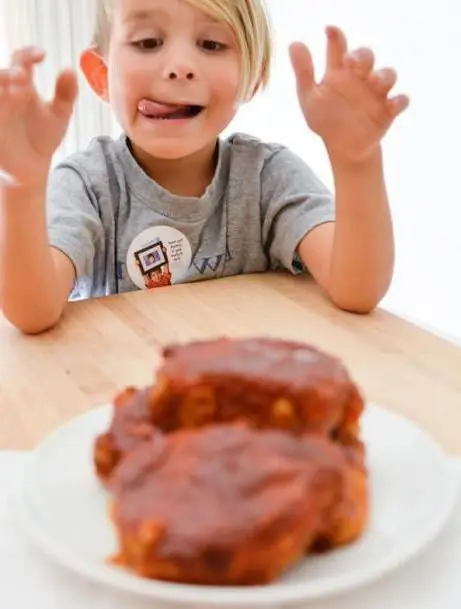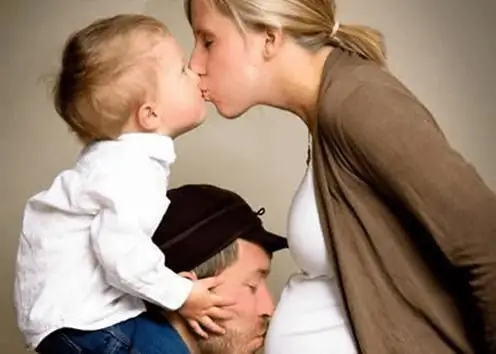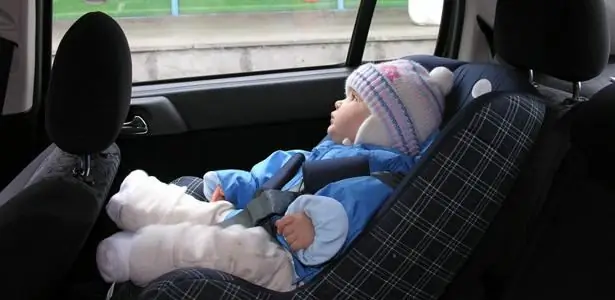2025 Author: Priscilla Miln | [email protected]. Last modified: 2025-01-22 17:55:16
Electrocardiography is a common procedure that allows you to determine the work of the heart muscle. ECG children can be performed in the first year of life. There are no contraindications for the procedure as such. Recently, even when they are discharged from the maternity hospital, many babies have an ECG done to make sure that the baby is completely he althy.

What is an ECG?
Electrocardiogram has long established itself as the most informative, simple method for studying the work of the heart muscle. As a result of contraction of the heart, electrical potentials are recorded by the device. This allows you to make special sensors that are easily attached to the body. The impulses are amplified by 600-700 times and enter a device called a cardiograph. He deciphers these impulses and displays them in the form of a graph on a special paper tape. The procedure is completely painless, takes little time, and is safe. Therefore, an ECG can be done for children at a very early age. This allows timely diagnosis of various dangerous diseases at the mostearly dates.
What can you learn from a cardiogram?
What does the ECG show in children? First of all, it gives an estimate of the heart rate. It also allows you to identify various metabolic disorders, it can be a deficiency of magnesium, potassium, or any other electrolytes. In this case, serious diseases such as:
- Congenital or acquired heart disease. Myocarditis.
- Anomalous increase (hypertrophy) of one or another part of the heart.
- Myocardial infarction.
- Angina.
- Heart blockade. Violation of intracardiac conduction, heart rhythm.
- Metabolic disorders caused by any pathological conditions, various diseases.
- Pulmonary embolism.

Benefits
There are times when babies are given a chest x-ray. This method is also effective in the examination, but it is most often used to confirm any disease. To learn more detailed information about the work of the heart, it is recommended to conduct an ECG for children. The advantages of such a procedure are obvious. What they are:
- Painlessness of the procedure itself. Parents know that children perceive any pain with horror, even the sight of electrodes can cause hysteria. However, they do not cause the slightest discomfort.
- The method is very simple, does not cause much stress for either the patient or the doctor.
- The procedure is inexpensive. You can go through it both for free and in a paid clinic.
- Speed. It won't take more than 10 minutes with all the preparations. The child does not even have time to be frightened. Any kid can withstand the process.
- ECG devices are being improved every year, acquiring new functions. A decoding with a detailed description (where a complete analysis of the heart rhythm is indicated, muscle rotations around the longitudinal, transverse axis) is performed as soon as possible. You can get the conclusion right away.
- No need to worry about finding a place to do an EKG. You can do the procedure in any clinic.

Features of ECG in children
Parents should know that the growing body of the baby has its own characteristics, at a given age, the indicators may be different. When conducting an ECG for children, doctors, of course, take this into account. So what are the characteristics of children's testimony?
- In infants, it often happens that the right ventricle predominates. Parents should not be afraid of this, this is the norm for infancy, with age it will decrease in size.
- The younger the child, the shorter the intervals shown by the electrocardiogram.
- Children's atria are slightly larger in size when compared to adult proportions, so don't be afraid to decipher the high P wave.
- There will always be a large number in the chest lead, so a negative T wave will appear.
- In the limit of the atria, the migration of rhythm sources.
- Alternations of prongs in the ventricular complex are normal.
- Incomplete blockade on theright leg of the bundle of His.
- Norm - sinus, respiratory arrhythmia.
- There is a possibility of a deep Q wave in the third standard lead (on the chest).
Once the ECG procedure is done, you can fully learn about the work of the baby's heart.

Carrying out an ECG
The procedure is carried out using a modern electrocardiograph device. Special electrodes are attached to the child's body, which perceive the electrical potentials generated in the heart, which, in turn, are recorded on paper. So how is an EKG done to children? In practice, 12 leads are used: 6 of them are fixed to the chest with suction electrodes, and the other 6 standard electrodes are applied to the limbs. To conduct an ECG in a child, electrodes of reduced size are used, they have a special shape so as not to cause skin injury to the baby. Some clinics use disposable suction cups, they are very soft and do not leave any marks. You can purchase a set of disposable sensors for newborns.
Modern devices make it possible to store readings in the internal memory of the device, record them on external media, and carry out primary processing. A complete transcript of the ECG, its interpretation, and the issuance of results is carried out by the doctor. For each child, the indications are individual, the options may have certain deviations, but they should not go beyond physiological norms.

How to make an ECG for a child withouttears?
The procedure does not cause any pain to the baby, but children are afraid of everything new, unusual, and therefore even the sight of suction cups can often unbalance them. If the procedure is for a baby, it is better to carry it out after feeding, during sleep, when the baby is relaxed, inactive. It is quite possible to pass an ECG to a child without tears. Children who already perceive what is happening need to be prepared a little. Play with them at home as a doctor, show the procedure on dolls, tell him that he has to go through it. Boys respond well to playing robots. Tell your son that he is going to be a robot with controlled wires attached. During the procedure, he will have to lie quietly, pretend to be asleep so that the enemy from the android army does not notice him. You will see how the baby will enjoy going to the clinic, he will even want to come back to play.
When an ECG is needed
Statistics show that every second resident of large cities consults cardiologists. Cardiovascular diseases, sadly, are in the first place among the problems associated with he alth. That is why all civilized countries make the ECG procedure in babies of the first year of life as mandatory. In addition, it is required:
- When passing a medical examination upon admission to a kindergarten, school.
- When passing medical examination.
- Before classes in any sports section.
- Before necessary operations.
- ECG should be done regularly for chronic ENT diseases.
- Afterpneumonia, bronchitis, tonsillitis to avoid complications.
- For any detection of a heart murmur.
If the baby gets tired quickly when sucking, the skin around the lips becomes cyanotic, in this case it is simply necessary to make an ECG to the child. Where to do - any pediatrician will tell you. All clinics have modern equipment that allows this painless procedure.
An ECG is also mandatory if the child suddenly lost consciousness, gets tired quickly, suffers from edema, dizziness, pain in the heart and joints. Be sure to call your pediatric cardiologist.

Indicators
So, let's look at the results of the child's ECG. Deciphering, the norm of indicators is slightly different from the ECG of an adult patient. However, the doctor always takes into account certain age characteristics when deciphering indicators in children. In particular, this is the heart rate - small children under the age of 3 years can have such an indicator from 100 to 110 beats per minute, and this is considered the norm. Over time, the heart rate decreases, and by puberty it should give an indicator that is more equivalent to an adult (from 60 to 90 beats per minute).
When deciphering the ECG readings in children, the doctor should note that the electrical impulses passing in the parts of the heart (in the elevation interval P, QRS, T) have readings from 120 to 200 ms, this equates to five squares. The QRS complex makes it possible to find out if the ventricles are excited. To do this, measure the interval betweenQ and S teeth, these indicators should not exceed the limits from 60 to 100 ms. Particular attention - the excitation of the right ventricle (V1-V2). Children's cardiogram often shows that this figure is higher than in the left. With age, these indicators return to normal.
Children's ECG chart often shows serrations, splitting, thickening on R-hills. Such an indicator in an adult would indicate bradycardia or tachycardia. For children, this is a common condition.
We talked about the norms of indicators. However, do not try to interpret the ECG results yourself, this issue should be de alt with by a highly qualified doctor.

Additional diagnostics
If the child is over three years old, a stress ECG is suggested for accurate results. That is, first they take a reading in a calm state, and then after some activity, excitement (the baby is allowed to spin the exercise bike, jump).
If a child has any deviations from normal indications, then the patient is sent for additional examinations. You need to undergo an ultrasound of the heart. The non-invasive procedure is completely painless, no traumatic agents are used.
Then, with the help of computed tomography, any pathologies in the work of the heart are determined and revealed.
Conclusion - parents should strictly monitor the he alth of their children, and the ECG procedure must be carried out regularly, normally once a year.
Recommended:
How to teach children to obey? Children's psyche, relations between parents and children, difficulties in raising a child

Surely, every parent at least once thought about how to teach a child to obey the first time. Of course, there is a sense in turning to special literature, to psychologists and other specialists, if the child refuses to hear you at all, and does not fulfill even the simplest and clearest requirements, acting in a completely different way. If the baby each time begins to show his “I don’t want, I won’t”, then you can deal with this on your own, without resorting to repression and extreme measures
When can children have soup? Soup puree for children. Milk soup with noodles for a child

In the article, we will consider when children can be given soup, from what foods it is best to cook it. For young mothers, we will give several different recipes and useful tips for boiling soups. We will pay special attention to milk soups and give recommendations from experts on complementary foods with vermicelli
At what age can a child be given pork? What can be cooked for a child from pork

The question of whether it is possible to give pork to children under one year old worries many parents. If yes, at what age? What pork dishes can be prepared for babies? The article provides answers to these questions
Can't get pregnant with my second child. Why can't I get pregnant with my second child?

A woman who once felt the happiness of motherhood, in the depths of her soul always wants to relive these wonderful moments of waiting and the first meeting with the baby. Some of the fair sex think about re-pregnancy immediately after the birth of their first child, others need time to make such a decision, while others plan their next child only when the first one starts going to school
Can children be transported in the front seat? At what age can a child ride in the front seat of a car?

Many parents wonder: "Is it possible to transport children in the front seat?". In fact, there is a lot of controversy about this issue. Someone says that it is extremely dangerous, and someone is a supporter of convenient transportation of the child, because he is always at hand. This article will talk about what is written about this in the legislation, as well as at what age a child can be transplanted into the front seat

